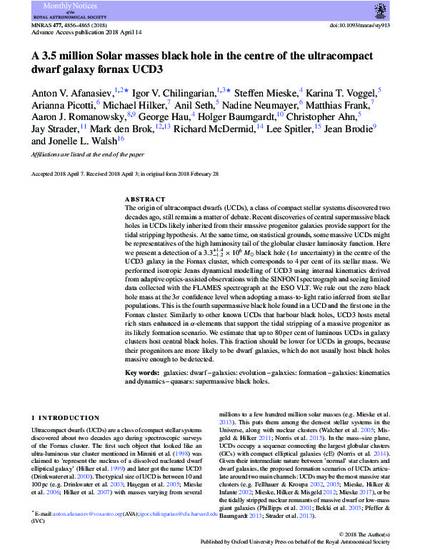
Article
A 3.5 million Solar masses black hole in the centre of the ultracompact dwarf galaxy fornax UCD3
Monthly Notices of the Royal Astronomical Society
(2018)
Abstract
The origin of ultracompact dwarfs (UCDs), a class of compact stellar systems discovered two decades ago, still remains a matter of debate. Recent discoveries of central supermassive black holes in UCDs likely inherited from their massive progenitor galaxies provide support for the tidal stripping hypothesis. At the same time, on statistical grounds, some massive UCDs might be representatives of the high luminosity tail of the globular cluster luminosity function. Here we present a detection of a 3.3+1.4−1.2×106M⊙ black hole (1σ uncertainty) in the centre of the UCD3 galaxy in the Fornax cluster, which corresponds to 4 per cent of its stellar mass. We performed isotropic Jeans dynamical modelling of UCD3 using internal kinematics derived from adaptive optics-assisted observations with the SINFONI spectrograph and seeing limited data collected with the FLAMES spectrograph at the ESO VLT. We rule out the zero black hole mass at the 3σ confidence level when adopting a mass-to-light ratio inferred from stellar populations. This is the fourth supermassive black hole found in a UCD and the first one in the Fornax cluster. Similarly to other known UCDs that harbour black holes, UCD3 hosts metal rich stars enhanced in α-elements that support the tidal stripping of a massive progenitor as its likely formation scenario. We estimate that up to 80 per cent of luminous UCDs in galaxy clusters host central black holes. This fraction should be lower for UCDs in groups, because their progenitors are more likely to be dwarf galaxies, which do not usually host black holes massive enough to be detected.
Keywords
- galaxies: dwarf,
- galaxies: evolution,
- galaxies: formation,
- galaxies: kinematics and dynamics,
- quasars: supermassive black holes
Disciplines
Publication Date
July 11, 2018
DOI
10.1093/mnras/sty913
Publisher Statement
This article was published in Monthly Notices of the Royal Astronomical Society ©: 2018 The Authors. Published by Oxford University Press on behalf of the Royal Astronomical Society. All rights reserved.
This article can also be found online at the following link: https://doi.org/10.1093/mnras/sty913
Citation Information
Anton V Afanasiev, Igor V Chilingarian, Steffen Mieske, Karina T. Voggel, et al.. "A 3.5 million Solar masses black hole in the centre of the ultracompact dwarf galaxy fornax UCD3" Monthly Notices of the Royal Astronomical Society Vol. 477 Iss. 4 (2018) p. 4856 - 4865 ISSN: 0035-8711 Available at: http://works.bepress.com/aaron_romanowsky/141/
